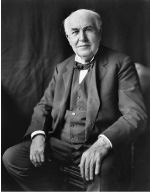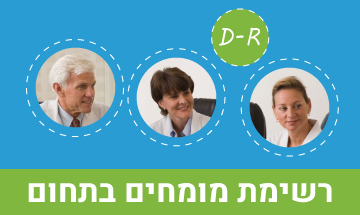And the lights turned on
 Thomas Edison
Thomas Edison born in 1847 in Milan, Ohio, grew up in Port Huron, Michigan. He developed hearing problems at an early age and ended just three months of official schooling. His mother taught him at home. Edison sold candy and newspapers on trains and later set in type and printed the
Grand Trunk Herald. This began Edison’s long streak of entrepreneurial ventures, that eventually led him to found 14 companies, including General Electric. He married twice and have three childreen each time. The invention that first gained him notice was the
Phonograph in 1877 as he travelled to Washington to present it before the National Academy of Sciences, Congressmen, Senators and US President. His major innovation was
Menlo Park, the first industrial research lab built in New Jersey with funds from the sale of Edison’s
quadruplex Telegraph. After his demonstration of the telegraph, Edison was not sure his original plan to sell it for $5,000 was right, so he asked Western Union to make a bid. He was surprised to hear them offer $10,000 which he gratefully accepted. In 1877, Edison invented and developed the
carbon Microphone used in all telephones along with the Bell receiver until the 1980s. While Edison did not invent the first electric light bulb, he invented the first commercially practical incandescent light and the first successful test in 1879 lasted 13.5 hours. He filed for U.S. patent for the
Electric Lamp using a carbon filament or strip coiled and connected to platina contact wires, and in 1878 funded the
Edison Electric Light Company in New York. It was during this time that he said: “We will make electricity so cheap that only the rich will burn candles”. Edison patented a system for electricity distribution in 1880 when he found the
Edison Illuminating Company. It was on September 4, 1882, that Edison switched-on his Pearl Street generating station’s electrical power distribution system, which provided 110 volts direct current (DC) to 59 customers in lower Manhattan. In 1887, there were 121 Edison power stations in the United States delivering DC electricity to customers. AC (Westinghouse) replaced DC in most instances, enormously extending the range and improving the efficiency of power distribution. There were still 1,600 DC customers in New York City as of 2005, and service was finally discontinued in 2007. Most subway systems are still powered by direct current. In 1891, Edison built a
Kinetoscope, or peep-hole viewer. This device was installed in penny arcades, where people could watch short, simple films. In April 1896, Thomas Armat’s Vitascope, manufactured by Edison factory and marketed in Edison’s name, was used to project motion pictures in public screenings in New York. Later he exhibited motion pictures with voice soundtrack mechanically synchronized with the film. Edison is also credited with designing and producing the first commercially available
Fluoroscope, a machine that uses X-rays to take radiographs. Until Edison discovered that calcium tungstate fluoroscopy screens produced brighter images than the barium platinocyanide screens used by Wilhelm Röntgen, the technology was capable of producing only very faint images. In 1892
Edison General Electric, merged with Thomson-Houston Electric Company to form
General Electric. In 1908, Edison started the
Motion Picture Patents Company, which was a conglomerate of nine major film studios. In 1927, Eddison was granted membership in the National Academy of Sciences and in 1929 became the first honorary fellow of the Acoustical Society of America. Edison died of complications of diabetes inNew Jersey in 1931 and is buried behind his home.
מקורות: וויקיפדיה



 Thomas Edison born in 1847 in Milan, Ohio, grew up in Port Huron, Michigan. He developed hearing problems at an early age and ended just three months of official schooling. His mother taught him at home. Edison sold candy and newspapers on trains and later set in type and printed the Grand Trunk Herald. This began Edison’s long streak of entrepreneurial ventures, that eventually led him to found 14 companies, including General Electric. He married twice and have three childreen each time. The invention that first gained him notice was the Phonograph in 1877 as he travelled to Washington to present it before the National Academy of Sciences, Congressmen, Senators and US President. His major innovation was Menlo Park, the first industrial research lab built in New Jersey with funds from the sale of Edison’s quadruplex Telegraph. After his demonstration of the telegraph, Edison was not sure his original plan to sell it for $5,000 was right, so he asked Western Union to make a bid. He was surprised to hear them offer $10,000 which he gratefully accepted. In 1877, Edison invented and developed the carbon Microphone used in all telephones along with the Bell receiver until the 1980s. While Edison did not invent the first electric light bulb, he invented the first commercially practical incandescent light and the first successful test in 1879 lasted 13.5 hours. He filed for U.S. patent for the Electric Lamp using a carbon filament or strip coiled and connected to platina contact wires, and in 1878 funded the Edison Electric Light Company in New York. It was during this time that he said: “We will make electricity so cheap that only the rich will burn candles”. Edison patented a system for electricity distribution in 1880 when he found the Edison Illuminating Company. It was on September 4, 1882, that Edison switched-on his Pearl Street generating station’s electrical power distribution system, which provided 110 volts direct current (DC) to 59 customers in lower Manhattan. In 1887, there were 121 Edison power stations in the United States delivering DC electricity to customers. AC (Westinghouse) replaced DC in most instances, enormously extending the range and improving the efficiency of power distribution. There were still 1,600 DC customers in New York City as of 2005, and service was finally discontinued in 2007. Most subway systems are still powered by direct current. In 1891, Edison built a Kinetoscope, or peep-hole viewer. This device was installed in penny arcades, where people could watch short, simple films. In April 1896, Thomas Armat’s Vitascope, manufactured by Edison factory and marketed in Edison’s name, was used to project motion pictures in public screenings in New York. Later he exhibited motion pictures with voice soundtrack mechanically synchronized with the film. Edison is also credited with designing and producing the first commercially available Fluoroscope, a machine that uses X-rays to take radiographs. Until Edison discovered that calcium tungstate fluoroscopy screens produced brighter images than the barium platinocyanide screens used by Wilhelm Röntgen, the technology was capable of producing only very faint images. In 1892 Edison General Electric, merged with Thomson-Houston Electric Company to form General Electric. In 1908, Edison started the Motion Picture Patents Company, which was a conglomerate of nine major film studios. In 1927, Eddison was granted membership in the National Academy of Sciences and in 1929 became the first honorary fellow of the Acoustical Society of America. Edison died of complications of diabetes inNew Jersey in 1931 and is buried behind his home.
Thomas Edison born in 1847 in Milan, Ohio, grew up in Port Huron, Michigan. He developed hearing problems at an early age and ended just three months of official schooling. His mother taught him at home. Edison sold candy and newspapers on trains and later set in type and printed the Grand Trunk Herald. This began Edison’s long streak of entrepreneurial ventures, that eventually led him to found 14 companies, including General Electric. He married twice and have three childreen each time. The invention that first gained him notice was the Phonograph in 1877 as he travelled to Washington to present it before the National Academy of Sciences, Congressmen, Senators and US President. His major innovation was Menlo Park, the first industrial research lab built in New Jersey with funds from the sale of Edison’s quadruplex Telegraph. After his demonstration of the telegraph, Edison was not sure his original plan to sell it for $5,000 was right, so he asked Western Union to make a bid. He was surprised to hear them offer $10,000 which he gratefully accepted. In 1877, Edison invented and developed the carbon Microphone used in all telephones along with the Bell receiver until the 1980s. While Edison did not invent the first electric light bulb, he invented the first commercially practical incandescent light and the first successful test in 1879 lasted 13.5 hours. He filed for U.S. patent for the Electric Lamp using a carbon filament or strip coiled and connected to platina contact wires, and in 1878 funded the Edison Electric Light Company in New York. It was during this time that he said: “We will make electricity so cheap that only the rich will burn candles”. Edison patented a system for electricity distribution in 1880 when he found the Edison Illuminating Company. It was on September 4, 1882, that Edison switched-on his Pearl Street generating station’s electrical power distribution system, which provided 110 volts direct current (DC) to 59 customers in lower Manhattan. In 1887, there were 121 Edison power stations in the United States delivering DC electricity to customers. AC (Westinghouse) replaced DC in most instances, enormously extending the range and improving the efficiency of power distribution. There were still 1,600 DC customers in New York City as of 2005, and service was finally discontinued in 2007. Most subway systems are still powered by direct current. In 1891, Edison built a Kinetoscope, or peep-hole viewer. This device was installed in penny arcades, where people could watch short, simple films. In April 1896, Thomas Armat’s Vitascope, manufactured by Edison factory and marketed in Edison’s name, was used to project motion pictures in public screenings in New York. Later he exhibited motion pictures with voice soundtrack mechanically synchronized with the film. Edison is also credited with designing and producing the first commercially available Fluoroscope, a machine that uses X-rays to take radiographs. Until Edison discovered that calcium tungstate fluoroscopy screens produced brighter images than the barium platinocyanide screens used by Wilhelm Röntgen, the technology was capable of producing only very faint images. In 1892 Edison General Electric, merged with Thomson-Houston Electric Company to form General Electric. In 1908, Edison started the Motion Picture Patents Company, which was a conglomerate of nine major film studios. In 1927, Eddison was granted membership in the National Academy of Sciences and in 1929 became the first honorary fellow of the Acoustical Society of America. Edison died of complications of diabetes inNew Jersey in 1931 and is buried behind his home.
